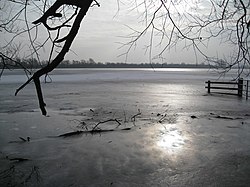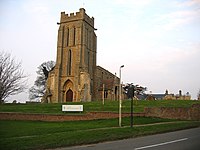Bury, Huntingdonshire
| Bury | |
| Huntingdonshire | |
|---|---|
 Winter sunshine on Bury Fen | |
| Location | |
| Grid reference: | TL284841 |
| Location: | 52°26’24"N, 0°6’36"W |
| Data | |
| Post town: | Ramsey |
| Postcode: | PE26 |
| Local Government | |
| Council: | Huntingdonshire |
Bury is a village in Huntingdonshire, close by the town of Ramsey. From Ramsey to Bury is a pleasant walk across the golf course, and though Ramsey is now the presideing town of the Huntingdonshire fens, it is Bury which was the mother parish to Ramsey, encompassing the town within its boundaries.
Bury was once two manors and two villages; Bury and Hepmangrove, which formed one parish by the name of Bury-cum-Hepmangrove. They are all one village today.
Today, Bury is a quiet roadside place. It has a mediæval church with a 13th Century tower looking out across not only the greens of the golf course but away over the broad expanse of the fens.
Bury lies to the south of Ramsey. The parish is of a very irregular shape, projecting a considerable distance into the fen on the east side of the road from Ramsey to St Ives. The land rises on both sides of the brook which runs through the parish from north-east to south-west from 16 feet above ordnance datum at the brook to 66 feet on the north-eastern; a considerable height for the fenland.
All of the fenland and much of the higher ground is ploughed. The soil is a strong black loam and the sub-soil is clay. The main crops are wheat, oats, beans and peas on the highland, and potatoes, celery, sugar-beet and ordinary cereals on the fenland.
Parish church

The Church of Holy Cross is of the 13th century, built of rubble with Barnack stone dressings. Its chancel is 27 feet by 14½ feet, nave 48 feet by 19½ feet and north aisle 7½ feet wide.
The church's lectern is a superb piece of 14th Century carved woodwork
An early 12th-century church which stood here probably consisted only of a chancel and nave; the east and west walls of the nave of this church survive. Early in the 13th century the north aisle with its nave arcade was added and in the middle of the same century the western tower was built. Possibly owing to defects in the foundations, the north wall of the north aisle was rebuilt in the 14th century. About 1400, considerable alterations were again made, the chancel and south wall of the nave were rebuilt and new windows inserted in the north aisle. Towards the end of the 15th century, the large chapel west of the tower was built, possibly as a Lady Chapel. The chancel was shortened by about 13 ft., probably in the 16th century, as may be seen by the remains of two windows at the eastern angles of the church. The porch was built and the church restored in 1889.
The windows in the north aisle are all a part of the rebuilding of about 1400. Each has two cinquefoiled lights in a square head and each contains some original glass. The north doorway is of a little earlier date and belongs to the rebuilding of the north wall in the 14th century. Remains of the old roof appear below the plaster. At the west end of the aisle is the font dating from about 1200. The bowl was originally square, but the angles have been cut off to form an octagon. It stands on a drum pedestal resting on a square base.
All that now remains of the late 15th-century west chapel is its east end, which is built of ashlar faced stone. On each side of the archway into the tower is a 15th-century niche with a mutilated tabernacle over it. The remains of a window may be seen at the eastern end of both the north and south walls.
Before the Reformation, the abbots of Ramsey had episcopal rights over Bury to the exclusion of the bishop. After the Dissolution, these rights passed to the lord of the manor who retained not only the right of presentation but the living, so that the incumbent was only a curate, until this relinquished in 1868. The Duke of Manchester is the present patron.
In Bacon's Liber Regis (1534–5) there is reference to the church of St. Mary of Hepmangrove, and a tradition exists that there was formerly a church there. In the Valor Ecclesiasticus (1535) the "chapel of the Blessed Mary of Redybone" is mentioned (iv, 272), and in 1538 we have references to the churchyard of Our Lady of Bury and Our Lady's Gild at Redebourn, and also the churchyard of St Mary of Bury . The church of Bury being dedicated to the Holy Cross, it may, perhaps, be suggested that the churchyard, chapel and gild of Our Lady relate to the chapel at the west end of Bury church, built possibly to serve the inhabitants of Hepmangrove, and that Redebourn may be an alternative name for Hepmangrove.
History
Bury and Hepmangrove, under the name of Bury-cum-Hepmangrove, appear to have originally been separate manors but were united for certain purposes before the Dissolution of the Monasteries in 1538.
The two villages have been recorded as:
* Biri, Byrig (10th C),
|
|
Originally, Bury was a chapelry of Wistow but by 1178 it became the parish with the village of "Wistow" as its chapelry. (Wistow gained a separate identity by 1351.) Bury's parish also absorbed Upwood, and Little Raveley until 1746.
Hepmangrove seems originally to have been connected with the Ramsey parish, and the brook running through the village of Bury formed the boundary between it and Bury. From the deeds relating to the tenements and lands situated within its boundaries, before the Dissolution of Ramsey Abbey, it appears to have been a populous suburb of Ramsey. Both Bury and Hepmangrove lay within the Banlieu.
Bury and Hepmangrove now form one village. They still retain several 17th century half-timbered thatched or tiled cottages, some of which have been refaced with brick, but most of the houses are of brick with slate or tile roofs. The former ancient stone bridge of one arch which crossed the Brook was replaced in 1925 by a wider bridge. The north-west side of the bridge is in Hepmangrove, in which the greater part of the village lies. The former Railway Station of Ramsey was originally in Bury parish, but current boundaries have shrunk back.
Manor
At the time of our earliest evidence relating to Bury, it was a berewick or out-lying district probably with a separate organisation, attached to Wistow or Kingston and formed part of the grant by Oswald Archbishop of York to Ramsey Abbey, about 974.
At some time before 1178, when the Pope granted a confirmation to Ramsey Abbey, Bury had become the head of this holding, and Wistow and Raveley were berewicks to it. Shortly after this date, at all events before 1252, Bury, Wistow and Raveley had become separate manors. Bury and Hepmangrove, under the name of Bury cum Hepmangrove, appear to have been united for certain purposes before the dissolution of Ramsey.
After the Dissolution, in 1540, these lands were granted as separate manors, to Richard Williams, alias Cromwell, and followed the descent of Ramsey until 1662, when Henry Williams and Anne his wife granted the manor of Bury cum Hepmangrove to John Bambridge. Various conveyances follow down the years. The Duke of Manchester is the present lord of the manor.
The earliest reference to Hepmangrove is in the statutes of Abbot Aldwin (1091–1102) under which the profits from the manor were assigned to the cellarer of Ramsey Abbey for finding and mending the utensils of the refectory, bakehouse and brewhouse.
From a survey of the time of Henry I, three tenants each rendered one or two bolls of honey. During the 13th and 14th centuries, much of the land in Hepmangrove was granted for religious purposes. In 1352 Philip de Clarvaux gave lands, the profits of which were to be expended in prayers for his own soul, and those of Emma his wife and his ancestors. In 1307 John de Lincoln, parson of the church of Cranfield, and others, granted lands here and in Ramsey and Bury for finding tapers to burn before the tomb of St Ivo in the Abbey church. Other lands were given by Henry Malpas in 1396 for the maintenance of the Lady Chapel in the Abbey church, then newly built.
The manor remained with Ramsey Abbey till the Dissolution, when it was granted with Ramsey and Bury on 4 March 1539–40 to Richard Williams alias Cromwell and since then has followed the descent of the manor of Bury
Sports & Bury Fen
Bury Fen is located just a few miles outside of St Ives, between Bluntisham and Earith, and is the birthplace of bandy, now a sport accepted by the International Olympic Committee.[1] According to documents from 1813 Bury Fen Bandy Club was undefeated for 100 years. A member of the club, Charles Tebbutt, wrote down the 1st official rules in 1882. He was also contributing a lot to spreading the sport to many countries.[2]
Outside links
| ("Wikimedia Commons" has material about Bury, Huntingdonshire) |
